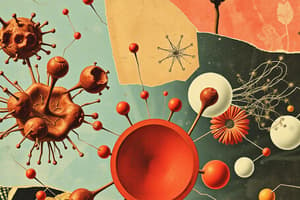Podcast
Questions and Answers
Which of the following serum proteins primarily functions to maintain osmotic pressure in the blood?
Which of the following serum proteins primarily functions to maintain osmotic pressure in the blood?
- Fibrinogen
- Urea
- Globulins
- Albumin (correct)
If a patient exhibits symptoms of a bleeding disorder, which serum protein level should be evaluated?
If a patient exhibits symptoms of a bleeding disorder, which serum protein level should be evaluated?
- Fibrinogen (correct)
- Albumin
- Creatinine
- Globulins
Which type of globulins primarily function as antibodies and provide immunity against infections?
Which type of globulins primarily function as antibodies and provide immunity against infections?
- Gamma globulins (correct)
- Alpha globulins
- Beta globulins
- Delta globulins
What process describes the constant breakdown of proteins into amino acids?
What process describes the constant breakdown of proteins into amino acids?
In the context of amino acid metabolism, what is the primary purpose of transamination?
In the context of amino acid metabolism, what is the primary purpose of transamination?
Which process in the liver is responsible for converting ammonia into a less toxic substance for excretion?
Which process in the liver is responsible for converting ammonia into a less toxic substance for excretion?
Why is the control of ammonia levels important for brain health?
Why is the control of ammonia levels important for brain health?
What is the primary purpose of the urea cycle in the human body?
What is the primary purpose of the urea cycle in the human body?
If a patient's renal function tests show elevated levels of blood urea nitrogen (BUN) and creatinine, what condition might this indicate?
If a patient's renal function tests show elevated levels of blood urea nitrogen (BUN) and creatinine, what condition might this indicate?
Which of the following statements correctly describes the relationship between the liver and the urea cycle?
Which of the following statements correctly describes the relationship between the liver and the urea cycle?
A patient presents with edema, suggesting fluid accumulation in tissues. Which serum protein deficiency is most likely contributing to this condition?
A patient presents with edema, suggesting fluid accumulation in tissues. Which serum protein deficiency is most likely contributing to this condition?
In amino acid metabolism, what is the consequence of deamination?
In amino acid metabolism, what is the consequence of deamination?
Patients with liver disease sometimes develop hepatic encephalopathy due to the buildup of toxins in the blood. Which metabolic process is most directly impaired in these individuals?
Patients with liver disease sometimes develop hepatic encephalopathy due to the buildup of toxins in the blood. Which metabolic process is most directly impaired in these individuals?
Which of the following best describes the role of kidneys in urea metabolism?
Which of the following best describes the role of kidneys in urea metabolism?
How does the body prevent the accumulation of toxic ammonia produced during amino acid metabolism?
How does the body prevent the accumulation of toxic ammonia produced during amino acid metabolism?
Which of the following best explains why essential amino acids must be obtained through the diet?
Which of the following best explains why essential amino acids must be obtained through the diet?
Which statement accurately describes the genetic control of protein synthesis?
Which statement accurately describes the genetic control of protein synthesis?
A researcher is studying the transport of fat-soluble vitamins in the blood. Which serum proteins should they focus on?
A researcher is studying the transport of fat-soluble vitamins in the blood. Which serum proteins should they focus on?
What is the initial effect of excess ammonia on the central nervous system?
What is the initial effect of excess ammonia on the central nervous system?
How do renal function tests, such as measuring blood urea nitrogen (BUN) and creatinine levels, aid in diagnosing kidney diseases?
How do renal function tests, such as measuring blood urea nitrogen (BUN) and creatinine levels, aid in diagnosing kidney diseases?
Flashcards
Albumins
Albumins
The most abundant serum proteins, synthesized by the liver, maintaining osmotic pressure in the blood.
Globulins
Globulins
Serum proteins including alpha, beta, and gamma types. Alpha and beta transport lipids, while gamma are antibodies.
Fibrinogen
Fibrinogen
A protein essential for blood clotting; it is converted into fibrin during the clotting process.
Protein Synthesis
Protein Synthesis
Signup and view all the flashcards
Protein Degradation
Protein Degradation
Signup and view all the flashcards
Transamination and Deamination
Transamination and Deamination
Signup and view all the flashcards
Ammonia Detoxification
Ammonia Detoxification
Signup and view all the flashcards
Urea Cycle
Urea Cycle
Signup and view all the flashcards
Urea Metabolism
Urea Metabolism
Signup and view all the flashcards
Renal Function Tests
Renal Function Tests
Signup and view all the flashcards
Study Notes
Serum Protein and Its Components
-
Serum proteins are essential for maintaining physiological functions
-
They are classified into albumins, globulins, and fibrinogen
-
Albumins are the most abundant serum proteins
-
They are synthesized by the liver
-
They maintain osmotic pressure in the blood
-
They ensure fluid distribution between blood vessels and tissues
-
Low albumin levels (hypoalbuminemia) can lead to edema
-
Globulins include alpha, beta, and gamma globulins
-
Alpha and beta globulins transport lipids and fat-soluble vitamins
-
Gamma globulins are antibodies produced by the immune system
-
They provide immunity against infections
-
Fibrinogen is crucial for blood clotting
-
It converts into fibrin
-
Disorders affecting fibrinogen levels can lead to bleeding disorders or excessive blood clotting
Amino Acid Metabolism
-
Amino acids form proteins
-
Metabolism includes synthesis, breakdown, and interconversion
-
Essential amino acids must be obtained through diet
-
Non-essential amino acids can be synthesized by the body
-
Protein synthesis involves linking amino acids in specific sequences
-
DNA determines the amino acid sequence
-
Protein degradation (proteolysis) breaks down proteins into amino acids
-
The resulting amino acids can be used for energy or to synthesize new proteins
-
Transamination: Amino acids are interconverted
-
The amino group is transferred from one amino acid to another
-
Deamination: Process involving removal of the amino group
-
It forms ammonia
-
Understanding amino acid metabolism is crucial for addressing conditions like protein-energy malnutrition and certain genetic disorders
Fate of Ammonia
-
Ammonia is a toxic byproduct of amino acid metabolism
-
The body has mechanisms to handle ammonia and prevent its accumulation
-
Ammonia detoxification converts ammonia into less toxic substances
-
Occurs through the urea cycle in the liver
-
Ammonia combines with carbon dioxide to form urea
-
Urea is then excreted in urine
-
Excess ammonia affects the central nervous system and can lead to hepatic encephalopathy
-
The brain is particularly sensitive to elevated ammonia levels
-
Understanding the fate of ammonia is critical for assessing liver function
Urea Cycle, Urea Metabolism, and Renal Function Tests
-
The urea cycle eliminates excess nitrogen from the body in the form of urea
-
Renal function tests provide insights into the efficiency of the kidneys
-
Urea cycle takes place in the liver
-
It is a series of enzymatic reactions that convert ammonia into urea
-
Urea is then transported to the kidneys for excretion
-
Kidneys filter urea from the blood and excrete it in the urine
-
Abnormalities in urea metabolism indicate kidney dysfunction
-
Blood urea nitrogen (BUN) and creatinine levels are common indicators used in renal function tests
-
Elevated levels suggest impaired kidney function
-
Understanding the urea cycle and renal function tests is essential for diagnosing and managing kidney diseases
-
Examples are acute kidney injury and chronic kidney disease
Studying That Suits You
Use AI to generate personalized quizzes and flashcards to suit your learning preferences.



